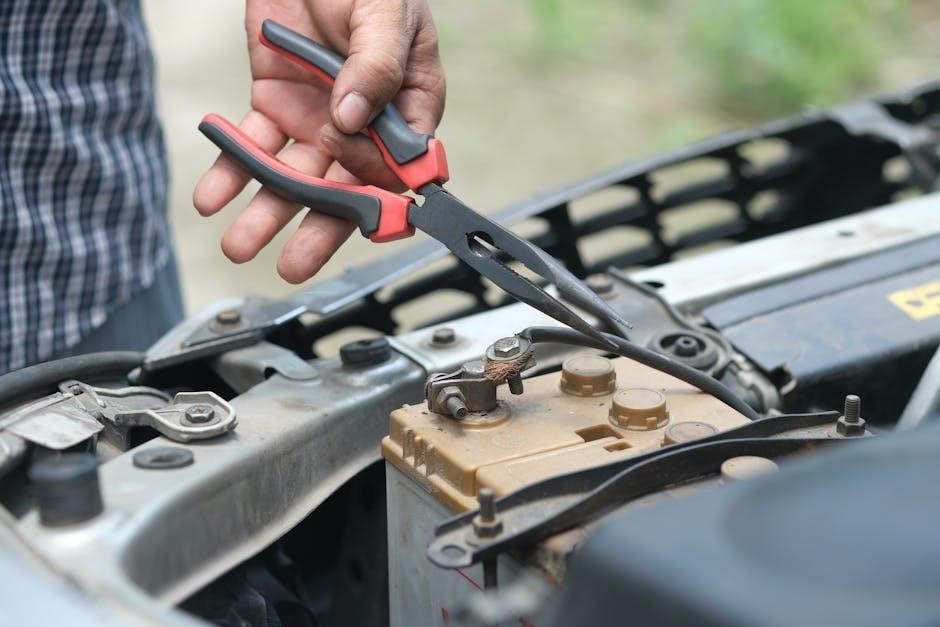The Astro MixAmp Pro TR is a professional-grade audio mixer designed for gaming headsets, offering enhanced sound control and customization for immersive gaming experiences.
Installation and Setup
Connect the MixAmp Pro TR to your PC or console using a USB cable. Set the mode switch to PC or console. Configure sound settings to select the MixAmp as the default device. Use the Astro Command Center for additional setup and customization options.
2.1. Connecting to PC
To connect the Astro MixAmp Pro TR to your PC, plug the Micro USB cable into the MixAmp and the USB end into your computer. Ensure the PC/PS4 mode switch is set to PC. Open your PC’s sound settings, navigate to the Playback Devices tab, and select the MixAmp Pro TR as the default device. For Mac, go to System Settings, select Sound, and choose the Digital Out option. Install the Astro Command Center software for additional customization, such as EQ settings and firmware updates. Restart your system to ensure the device is recognized and functioning properly.
2.2. Connecting to Consoles
To connect the Astro MixAmp Pro TR to your gaming console, start by switching the PC/PS4 mode switch on the MixAmp to the console position. For PlayStation, use the optical cable to connect the MixAmp to the PS4’s optical output. For Xbox, plug the USB end of the Micro USB cable into the Xbox and connect the other end to the MixAmp. Ensure the optical cable is securely attached to the console’s optical out port. Once connected, navigate to your console’s audio settings and select the MixAmp Pro TR as the default audio device. This setup ensures high-quality audio and voice balance for an immersive gaming experience.
2.3. Switching Between PC and Console Modes
To switch between PC and console modes on the Astro MixAmp Pro TR, locate the PC/PS4 mode switch on the device. For PC mode, set the switch to the PC position and connect the Micro USB cable to your computer. Ensure your PC sound settings recognize the MixAmp as the default playback device. For console mode, switch to the PS4 or Xbox position and use the optical cable to connect to your console’s optical output. On consoles, navigate to audio settings and select the MixAmp Pro TR as the default audio device. This seamless mode switching ensures optimal performance across both platforms, delivering high-quality sound tailored to your gaming setup.

Key Features
The Astro MixAmp Pro TR offers game-to-voice balance, EQ presets, volume control, and 7.1 virtual surround sound, enhancing audio customization for immersive gaming experiences.
3.1. Game-to-Voice Balance
The Astro MixAmp Pro TR allows users to adjust the balance between game audio and voice chat, ensuring clear communication without compromising in-game sound quality. This feature is particularly useful in multiplayer games, where both game sounds and team communication are crucial. By fine-tuning the balance, players can customize their audio experience to suit their preferences, whether they prioritize immersive gameplay or clear dialogue. The intuitive controls make it easy to adjust the balance on the fly, enhancing overall gaming performance and teamwork coordination. This feature is a standout aspect of the MixAmp Pro TR, catering to both casual and professional gamers alike.
3.2. EQ Presets
The Astro MixAmp Pro TR features multiple EQ presets, allowing users to tailor their audio experience to specific gaming scenarios. These presets optimize sound for different genres, such as FPS games requiring crisp footsteps or immersive cinematic experiences. Players can customize these settings to enhance dialogue clarity, bass response, or treble details, ensuring optimal audio performance. The ability to switch between presets on the fly adds flexibility, catering to diverse gaming needs. This feature is particularly beneficial for competitive gamers seeking precise soundscapes and casual players aiming for an enhanced auditory experience, making the MixAmp Pro TR a versatile tool for all types of gamers.
3.3. Volume Control
The Astro MixAmp Pro TR offers precise volume control, allowing users to adjust game and voice audio independently. This feature ensures a balanced audio experience, enabling players to customize their sound preferences. The mixer includes a physical volume knob for easy adjustments, while the Astro Command Center software provides additional options for fine-tuning levels. Independent control of game-to-voice balance ensures clear communication during multiplayer sessions. This flexibility is particularly beneficial for competitive gaming, where precise audio levels can enhance performance. The intuitive design makes it easy to manage volume settings, ensuring an optimal auditory experience tailored to individual preferences.

Audio Customization
The Astro MixAmp Pro TR offers comprehensive audio customization, including equalizer settings and preset management, allowing users to tailor their sound experience to personal preferences.
4.1. Equalizer Settings
The Astro MixAmp Pro TR features customizable EQ settings, enabling users to adjust frequency levels for a personalized audio experience. Through the EQ presets or manual adjustments, gamers can enhance bass, midrange, or treble to suit their preferences. This level of control ensures optimal sound quality, whether for immersive gameplay or precise voice chat clarity. The EQ settings are accessible via the Astro Command Center software, allowing seamless customization to match different gaming scenarios or media consumption needs.
4.2. Preset Management
The Astro MixAmp Pro TR allows users to create, save, and manage custom audio presets, ensuring a tailored experience for various gaming scenarios. Presets can be easily accessed and switched via the Astro Command Center software, enabling quick adjustments to equalizer settings, volume levels, and game-to-voice balance. This feature is particularly useful for professional gamers who require specific audio profiles for different games or environments. Additionally, users can organize and name their presets for easy identification, enhancing overall audio customization and convenience. This level of preset management ensures that users can optimize their audio settings efficiently, catering to both professional and casual gaming needs.

Technical Specifications
The Astro MixAmp Pro TR features a USB audio interface and optical input, supporting stereo sound and virtual 7.1 surround sound. It includes a high-quality digital-to-analog converter for clear audio output. The device is compatible with PC, Mac, PlayStation, and Xbox consoles, offering versatile connectivity. Built with durable materials, it ensures long-lasting performance. The MixAmp Pro TR also includes a removable microphone and a 3.5mm cable for flexible use. Its compact design integrates seamlessly with gaming setups, providing professional-grade audio control for enhanced gaming experiences. These specifications make it a reliable choice for both casual and professional gamers seeking high-quality sound customization and durability.

Troubleshooting Common Issues
Common issues with the Astro MixAmp Pro TR include no sound output, connectivity problems, or game-to-voice balance discrepancies. Ensure the device is properly connected to your PC or console, and verify that the correct input/output settings are selected in your system preferences. Restarting the MixAmp Pro TR or your connected device can often resolve connectivity issues. If no sound is detected, check the volume controls and ensure the device is not muted. For voice balance problems, adjust the dedicated knob or use the Astro Command Center software to fine-tune settings. If issues persist, updating drivers or resetting the device to factory settings may be necessary.
Maintenance and Care
Regular maintenance ensures optimal performance of the Astro MixAmp Pro TR. Clean the device with a soft cloth, avoiding harsh chemicals or liquids. Store the unit in a cool, dry place, away from direct sunlight. For the cables, avoid bending or twisting excessively, and keep them organized to prevent tangles. Update the Astro Command Center software periodically to ensure compatibility and access to the latest features. If not in use, disconnect the device to prevent power drain or damage. For deep cleaning, use compressed air to remove dust from ports and vents. Proper care extends the lifespan and maintains the quality of your MixAmp Pro TR.
The Astro MixAmp Pro TR is a powerful tool designed to elevate your gaming audio experience. With its advanced features like customizable EQ settings, game-to-voice balance, and robust build quality, it offers unparalleled control over your sound. Whether you’re a professional gamer or an enthusiast, this mixer delivers exceptional performance. Proper installation, setup, and maintenance ensure longevity and optimal functionality; By following the guidelines outlined in this manual, users can fully harness the potential of the MixAmp Pro TR, enhancing their gaming sessions with precise audio control and immersive sound. It’s a worthwhile investment for anyone seeking high-quality, tailored audio solutions.
References and Resources
For further information and support, refer to the following resources:
- Astro Gaming Official Website ─ Explore detailed product information and guides.
- Astro Support Page ─ Access troubleshooting, FAQs, and manual downloads.
- Astro Command Center ⏤ Download software for customizing settings and updating firmware.
- Astro Gaming Subreddit ─ Join the community for tips, discussions, and user experiences.
- YouTube Tutorials ⏤ Watch video guides for setup and customization.
- FAQ Section ─ Find answers to common questions about the MixAmp Pro TR.
These resources provide comprehensive support for optimizing your Astro MixAmp Pro TR experience.






































































